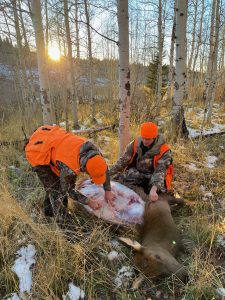Dry Dressing Moose

By V. Paul Reynolds
Like Johnny Cash sings, “One piece at a time.” Think of a moose as coming in seven or eight pieces—two hind quarters, two front quarters, two backstraps, one big package of trim meat and an optional head. As moose increasingly shy away from roadways and roam more back in the clear cuts, the quartering option becomes the best, and sometimes only choice.
Make sure you have a great backpack, headlamps, rope, six good game bags, a sharp knife and a way to keep it sharp. A small tarp or cloth to keep meat off the dirt helps.
A beginning moose hunter should practice quartering and packing a deer. Deer and moose share the same anatomy, just different sizes.
I use the dry dressing or sometimes called the gutless method of cleaning my moose, which means simply I don’t gut it. I’ll explain.
Start with the moose on its side. Make one long dorsal cut from the base of the skull to the base of the tail, following the backbone. Skin the hide off one side to get it cooling fast.
As a reminder, always cut with the grain of the hair. Cutting across or into the grain removes more hair from the follicles, littering your meat. Working across the hair will dull your blade very fast.
Quartering
Once the hide is off, lift the front leg straight up, cutting the muscle and cartilage as you go. The front quarter will detach easily. Place the quarter in a game bag.
Starting at the base of the neck, cut the backstrap free from the spine by making a cut parallel to the blades of the spine all the way to where the pelvis and hip join with the spine. Grip that backstrap and make a cut 90 degrees perpendicular to your first cut, right along the top of the ribs. Peel the backstrap away as you go. At the hip-spine intersect, cut off the backstrap. Voila!
With the moose still on its side, lift the back leg as high as you can, giving you access to the pelvic area. Tie the leg off in the raised position, or have a friend hold it while you do your work. Maine requires the genitalia stay attached as proof of sex, so decide which hind quarter will retain that evidence.
You now have access to where the pelvic bone comes together between the legs. Fillet the hind quarter along the pelvis bone until you get to the ball-joint socket of the hip. Cut the tendon in the hip socket, and it will release the entire hind quarter, allowing you to fillet the remainder of the rump off the pelvic bones. You can now cut the hoof off and place the hind quarter and in a game bag.
Game Bags
Remove all trim meat from this side, the flank, and especially the meat over and between the ribs. The neck will have a lot of meat. To access the tenderloin or innerloin on this side, go in right behind the last rib and cut the tip of the tenderloin where it attaches to the bottom of the spine. Reach your hand in, loosening the tenderloin as you work down to where it connects to the pelvis, cutting it free.
You are now done with one side. Flip the elk over and repeat the process. When both sides are complete, get your packs loaded and get the meat to a hanging or storage place. And remember, meat first, antlers last.
The Maine Department of Inland Fisheries and Wildlife has an excellent video on its website that demonstrates in excellent detail the dry dressing process.
For more articles about hunting, fishing and the great outdoors, be sure to subscribe to the Northwoods Sporting Journal.
